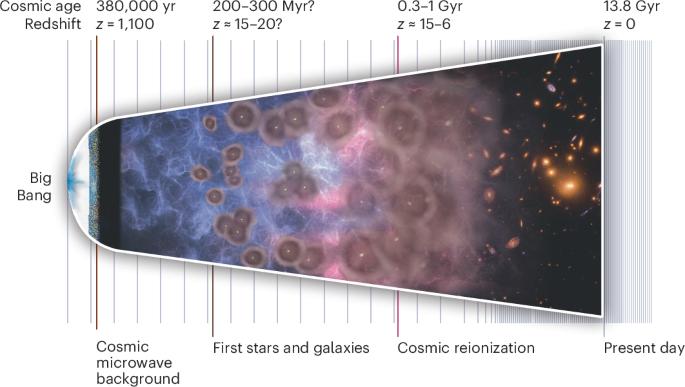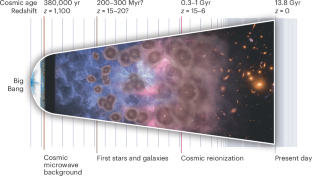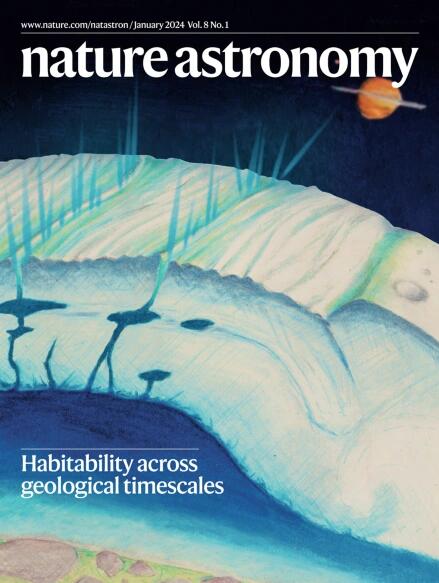根据JWST,第一个十亿年
IF 14.3
1区 物理与天体物理
Q1 ASTRONOMY & ASTROPHYSICS
引用次数: 0
摘要
JWST以惊人的清晰度揭示了宇宙最初的十亿年。科学界正在分析来自那个时代的大量JWST成像和光谱数据,并正在重写天文学教科书。在这里,作为2024年ISSI突破研讨会的结果,我们提供了一个关于JWST科学任务1.5年来在理解我们宇宙历史的初始章节方面取得的巨大进展的快照。我们介绍了JWST所揭示的早期星系的光度、外观、化学成分、质量和形成历史。我们在早期星系中发现了大质量黑洞,并讨论了它们的人口统计学特征及其形成和增长的含义。最后,我们描述了再电离的潜在来源,以及我们目前对宇宙如何完全电离的理解。在整个展望中,我们强调了发现和突破,尚未理解的主题和问题,以及将在未来几年解决的问题,因为JWST将继续对早期宇宙进行革命性的观测。本文章由计算机程序翻译,如有差异,请以英文原文为准。


The first billion years according to JWST
With stunning clarity, the JWST has revealed the Universe’s first billion years. The scientific community is analysing a wealth of JWST imaging and spectroscopic data from that era, and is in the process of rewriting the astronomy textbooks. Here, as a result of the 2024 ISSI Breakthrough Workshop, we provide a snapshot of the great progress made towards understanding the initial chapters of our cosmic history 1.5 years into the JWST science mission. We present the current census of early galaxies, their luminosities, appearance, chemical composition, masses and formation histories as revealed by JWST. We relate the discovery of massive black holes in early galaxies and discuss their demographics and implications for their formations and growth. We conclude by describing the potential sources of reionization and our current understanding of how the Universe became fully ionized. Throughout the Perspective, we highlight discoveries and breakthroughs, topics and issues that are not yet understood, and questions that will be addressed in the coming years, as JWST continues its revolutionary observations of the early Universe. The infrared view of JWST has opened up the early Universe to study. This Perspective summarizes the key developments in our understanding of the high-redshift Universe from the first 18 months of JWST observations.
求助全文
通过发布文献求助,成功后即可免费获取论文全文。
去求助
来源期刊

Nature Astronomy
Physics and Astronomy-Astronomy and Astrophysics
CiteScore
19.50
自引率
2.80%
发文量
252
期刊介绍:
Nature Astronomy, the oldest science, has played a significant role in the history of Nature. Throughout the years, pioneering discoveries such as the first quasar, exoplanet, and understanding of spiral nebulae have been reported in the journal. With the introduction of Nature Astronomy, the field now receives expanded coverage, welcoming research in astronomy, astrophysics, and planetary science. The primary objective is to encourage closer collaboration among researchers in these related areas.
Similar to other journals under the Nature brand, Nature Astronomy boasts a devoted team of professional editors, ensuring fairness and rigorous peer-review processes. The journal maintains high standards in copy-editing and production, ensuring timely publication and editorial independence.
In addition to original research, Nature Astronomy publishes a wide range of content, including Comments, Reviews, News and Views, Features, and Correspondence. This diverse collection covers various disciplines within astronomy and includes contributions from a diverse range of voices.
 求助内容:
求助内容: 应助结果提醒方式:
应助结果提醒方式:


